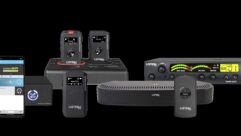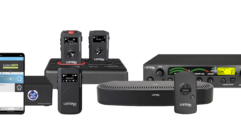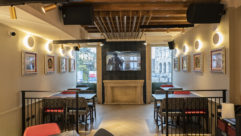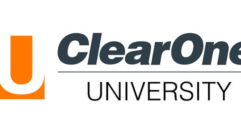Information Technologies: The Heart of Rock ‘n’ Roll
May 20, 1996 12:00 PM,
Jim Cudahy
The Rock and Roll Hall of Fame and Museum in Cleveland, known informally as Rock Hall, is definitely not your father’s museum. It is a 150,000 ft2 (13,935 m2) environment that collects and reflects the music and culture of the rock ‘n’ roll generations. It is a place that chronicles rock ‘n’ roll’s diversity, including Detroit’s Motown, Sun Records of Memphis, New York punk and rap, Seattle grunge and San Francisco psychedelic, all under one roof. The Beatles, James Brown, Rolling Stones, Lead Belly and Sting are alongside one-hit wonders. As executive director Dennis Barrie said in Time, “We are a museum with an attitude,” and jokingly quipped, “Welcome to our organized chaos.” An apt statement for the music of our generation _ a statement Rock Hall makes on every floor. This chaos posed a unique challenge for the systems integrator.
As one of three prime contractors, Design & Production (D&P) was responsible for turnkey exhibit detailing, fabrication and installation, as well as media systems engineering, control and installation. The Burdick Group carried out the exhibition design, and Turner Construction Company was responsible for general construction. All three worked together in a team structure coordinated by Peter Arendt, who served as director of construction for the museum.
The tightly knit team approach was critical to the success of the project. Installation had to be within a three-month window, yet stay flexible enough to allow the owner, curators and designers to respond to new opportunities and insights.
The magical mystery tour
The public enters through a 3,000 ft2 (278.7 m2) promenade level featuring three sit-down theaters and 13 exhibit areas. There are 25 visitor-interactive audio-video information kiosks, four videowalls containing 136 monitors, 19 individual wall- or case-mounted monitors and four rear-screen projection displays. In addition to the multimedia displays, wall and freestanding exhibits display thousands of historic artifacts, silk-screened text and graphics. Many include mannequins with costumes and wigs styled to the era of the musical heritage.
The experience begins at the unique dual theater. Two audiences are entertained at once, with the “Mystery Train” presentation in Theater One and “Take it to the Limit” in Theater Two. An AMX system automates the theater from the start of the first show, including lighting and door control, through the second presentation.
The videowall displays use Electro-sonics processors with Dotronix 25 inch (635 mm) monitors. Two 6×8 videowall arrays, nine audio channels and three laserdisc feeds create the main display for the hall. The “Rock Around the Clock” theater integrates a 4×4 and a 4×6 videowall matrix in a circular environment, with 10 audio channels using seven laserdisc sources.
All audio systems are based on Bose loudspeakers with Rane amplifiers and equalizers. Most of the exhibit audio is created by 128 Bose 102 loudspeakers routed from the control centers, with Bose Panaray units employed in all theaters. Audio is kept low in most areas to focus sound on individual exhibit subjects. Typical with this type of facility, the key challenge was to provide an aesthetic, transparent loudspeaker placement, yet maintain the high acoustic standards for the site.
The promenade level is also home to the interactive multimedia archive of rock music and video. The fully computerized library is powered by a Sun Sparc dual-processor server that drives the 64 gigabyte database. A Starlight data network allows users to access more than 500 songs and 148 minutes of noncompressed video from 25 Sony CPD monitors with Microtouch touchscreens. A Macintosh 840 Quadra AV provides each station with a full set of search tools, as well as audio and video presentation. Designed with future upgrades in mind, the library will eventually hold up to 10,000 songs and videos. With a touch on a centralized control panel, an operator can route keyboard and mouse to one of the 25 Macintosh interactive displays on the first and second floors.
This is ground control
Media automation, routing and monitoring are housed in a central control room at the Promenade level, with a supplemental room on the second floor. A walker duct and conduit network connects all exhibit areas to one of the two rooms. Designed for hands-free automated operation, the central system includes Sony program monitors, Extron switchers, Sigma distribution amplifiers and AMX LCD touch panels for simplified monitoring.
Automation is driven by a central AMX AXCESS CardFrame system with a data link to independent AXCESS systems on the second and fourth floors. All the automation and daily show schedules are run from a custom program kept in the AXCESS CardFrame Master Card. The program structure allows easy editing of time and laserdisc frame commands to accommodate future changes. A second Master processing-memory card can be used as a backup and will take control if a failure in the primary Master Card is detected.
Each of the building’s 35 Sony LDP 1550 and 24 Pioneer LDV-8000 laserdisc players is controlled by an AXC-232 RS-232 control card, which calls out frame, play and pause operation during the shows. The final configuration will use an AXC-SMP interface card for SMPTE time-code operation, which will allow the show to maintain synchronization of special effects if the show is paused. The front-access card slots of the CardFrames allow all cards to be replaced in an instant, simplifying maintenance.
Start me up
The data link to other AMX AXCESS systems opens a pathway for coordinated facility-wide activity. At the start of the day, the central system sends a time mark over the data link, synchronizing the internal clocks of each to the same time reference. When the fire-security system sends an alarm to an input on the central AXCESS system, an emergency code is broadcast to the other systems. This automatically places all media shows on hold and forces the laserdisc players to a pre-assigned emergency video frame. This is a good example of how close teamwork between the systems and creative staff can create cost savings, in this case by eliminating secondary video routing systems.
It’s only rock ‘n’ roll
The second level, encompassing 5,000 ft2 (464.5 m2), is devoted to rock ‘n’ roll memorabilia, including movies, radio, television, record production and print media. The centerpiece is the Rock and Roll Music Video exhibit, a tree-like circular steel and glass structure that presents “Video Killed the Radio Star.” It contains 24 monitors, from 13 inch to 27 inch (330 mm to 686 mm), mounted without their exterior housings. Four laserdisc players supply video and audio to the monitors and overhead loudspeakers.
The fourth floor (the third floor is set aside for future expansion) contains the Hall of Fame auditorium and a 1,000 ft2 (929 m2) live DJ booth. Communications Engineers, under subcontract to D&P, provided systems engineering and installation for the broadcast systems. Manned by guest disc jockeys, the booth has been in continuous operation since the opening of Rock Hall.
The auditorium is used for audio-video playback of past Hall of Fame induction ceremonies and daily running of the “Rock Is…” presentation. SoundCom of Cleveland provided the auditorium systems; D&P supplied the Hughes-JVC video projector and the “Rock Is…” automation for the AMX AXCESS controllers.
You arrive at the focal point of Rock Hall as you move through the fifth-floor exhibits and up to the final floor. The dramatic 1,000 ft2 (929 m2) sixth-floor area features Star-Fire edge-lit glass walls displaying the signatures of the rock stars honored with induction into the Hall of Fame. Grayscale LCD video displays are integrated into the structure, presenting images of the inductees stored in RAM hard drives within 60 Databrick computer systems.
Taking it to the limit
Rock Hall is a project that joins the role of sound and video contracting and exhibit house design and fabrication. The effort required the full scope of sound and video skills. These ranged from interpreting the design team’s guidelines and concepts to engineering and installing complex audio, video, control and computer network systems.
For example, the four rear-projection screens in the Rolling Stones and Little Richard displays were custom-fabricated by D&P. Da-Lite Screen material stretched over contoured metal tubing that bends and rolls around the contour of the entire exhibit for a unique effect. Da-Lite’s help in putting together these screens is an excellent example of manufacturer support.
Besides fabrication of all exhibit structures, D&P’s exhibit team had the task of engineering and fabricating more than 3,000 custom mounts and the installation of the artifacts. Examples include a decorative arrangement of more than 1,200 drumsticks from Peter Lavengar’s collection, more than 50 guitars, original sheet music, record covers, costumes _ including one of Elvis’ blue suede jackets _ dolls, souvenirs, personal mementos, a complete stage set from a Rolling Stones concert and a recreation of the Sun Record Studio of Memphis.
The success of the project can be seen in the interaction among the design, systems and construction teams. Working together, the team offered value-engineering solutions at all levels, which resulted in a greater scope and variety of exhibits than originally envisioned by the client. As an example, D&P, with other partners, secured more than $100,000 in donated equipment, allowing the interactive Rock Library to be economically feasible.
The goal of the team, curators and owners was to present an experience of rock ‘n’ roll while describing the culture from which the music came. Although there is an intentional air of chaos within Rock Hall, its successful day-in, day-out operation rests on organization, control and coordination.
TI>How It’s MadeJust in TimeQSC’s automated manufacturing methods get parts in and amps out in record time.
Located next to a strawberry field on a stretch of Southern California real estate between Santa Ana and Fountain Valley, QSC Audio’s main manufacturing facility and administrative offices are found at 1675 MacArthur Blvd. in Costa Mesa. Outwardly sleek and modern, the building’s gray exterior is punctuated with long spans of glass reflecting a calm, linear sense of order into the heavy swells of traffic rolling up and down the bordering streets.
Ignore the traffic noise, and you’re left with audible evidence that belies the fact that 21,000 ft2 (1,951 m2) of the QSC facility’s total space of 51,000 ft2 (4,738 m2) is given over to manufacturing. There’s no industrial-related clamor to speak of, and the bumper-to-bumper bustle often found in areas of commerce devoted to such activity is conspicuously absent. In fact, the longer you stand there and absorb what the surroundings have to offer, the more you’re overtaken by an aura of mindful calculation and efficiency.
This notion arrives by no accident. It’s all part of a plan conceived by the design team responsible for bringing the facility to life. Guided by a philosophy emphasizing the creation of flexible production methods capable of making rapid changes to meet the demand of QSC’s customers while offering the highest quality possible, the team’s manufacturing blueprint also managed to reduce cost and provide up-to-the-minute technology. As a direct outgrowth of this philosophy, a material handling and test strategy ultimately evolved that yielded dramatically improved efficiency and a bare-knuckled increase in production capacity. Viewed within the hyper-competitive world of amplifier manufacturing, all of these elements are vital to success, not to mention just plain survival.
In assembling the manufacturing design team, QSC relied upon both internal talent and top-notch hired guns from the outside. On the inside, QSC’s John Andrews, Bob Meigs and Eric Anderson mapped out the details of a combined manufacturing vision based upon their years of experience. They retained Silicon Valley’s CMP Group working under the direction of Wyatt Hyora. As a material handling consultant, Hyora has amassed an impressive client list over the years, including the likes of Apple Computer, Sun MicroSystems, Borland Software and Lockheed. Once Hyora and the internal QSC group came up with a basic conceptual plan, FloStore Engineering of Hayward, CA, jumped in to lend its systems integration skills to the entire affair.
QSC’s materials handling and manufacturing processes are capable of quickly responding to market needs, thanks to a number of automated systems and shrewd management of time, inventory and materials handling. Although QSC has directed a great amount of effort toward providing quick manufacturing response times, the company has spent just as much time discovering the best ways to reduce waste and add value at virtually every step along the way.
As testimony to the efficacy of their methods, consider that when the manufacturing processes were first implemented in the fall of 1992, manufacturing throughput was increased by 70% while space allotted to the process only rose 15%. Annual work-in-process inventory turns ranged from 25 to 80, and on average, it took a little more than three days to finish a production run. Today, following four more years of streamlining and refinements, yearly work-in-process inventory turns range from 500 to 1,200, and the time span from raw parts to finished product can be less than one day.
In its simplest sense, QSC’s master material handling plan accommodates faster product cycle times by using what’s referred to as a demand-pull method to introduce the necessary components into the assembly process. Demand-pull at QSC is driven by daily meetings to determine which products will be made when.
“Work forecasts are generated about three months in advance,” QSC sales administrator Patty Howland said. “So we have some advance guidelines of production, but invariably a situation arises where we need some products sooner. Luckily, since we subscribe to just-in-time (JIT) inventory methods, we have the flexibility to switch things around rapidly, usually with just a day’s notice. JIT has worked out well from a sales and marketing standpoint. Production, for the most part, functions according to orders, and that’s the idea.”
Just like everything else at QSC, material handling is viewed as a cooperative venture. It’s not a fight of special interests in any sense, and that is one of the key elements vital to the success of the entire process. At the heart of the material handling strategy is an automated transport system that allows workers to perform assembly tasks by simply pulling parts from revolving carousels or conveyors moving carriers equipped with RF identification tags. Parts are replenished within this system by suppliers in accordance with QSC’s current JIT manufacturing principles.
As its name implies, JIT is designed to deliver the necessary elements required in manufacturing right when they are needed. The major benefit of JIT is a reduction of inventory investment on both an economic and spatial scale. With regard to the former, outlays of cash are reduced significantly because QSC doesn’t have to store materials in great volumefewer out-of-pocket expenses for rent, taxes, insurance and the like. As an indicator of how well QSC’s JIT methods perform, consider that although the company grew 80% between the fall of 1992 and the summer of 1994, total inventory increased only a minuscule 1.4%.
So at this point, even if you didn’t give a JIT before, you may be wondering where the myriad components lining the circuit boards of a QSC amp come from.
“Amplifier manufacturing involves a lot of little parts like screws, bolts, capacitors and resistors,” QSC COO John Andrews said. “Then there are large high-value items that are often difficult to handle, such as transformers, chassis and heat sinks. Automation and planning have helped us greatly in reducing inventories of all these items, but to a larger degree, we rely upon close relationships with key suppliers who have been certified for quality and delivery performance. The products they provide are placed into the manufacturing system without inspection. More than 16 suppliers participate in the program, and among these, several have made master purchase agreements with us that allow one purchase order to cover all the products purchased for the term of the contract. One invoice, then, replaces the blizzard of paper normally associated with frequent deliveries, and suppliers can plan their production runs within the context of a guaranteed long-term deal. Negotiated just once, these contracts contain provisions for price deviations. Delivery dates are projected for the whole term, which are tracked through our MRP system.”
As in traditional amplifier manufacturing, all of the parts QSC needs to create finished products arrive at the back door. That’s where similarities end. According to the tenets subscribed to within QSC’s game plan, as many of the parts as possible coming in go directly to their point of use in the assembly process. Those parts that can’t be injected directly into the production scheme are taken to an automated storage and retrieval system (ASRS) consisting of a bank of double-stacked horizontal carousels or are placed in special plastic containers called Kanban bins loaded directly onto an automated assembly carousel.
“We only like to touch material when we can add value,” according to Andrews. Therefore, to reduce manual materials handling steps, some components in the manufacturing process arrive from the vendor in special reusable carriers. This does away with much of the packing material plus the related packing and unpacking and eliminates the use of expensive shipping cartons. After they’ve passed through final assembly, they simply go back to the vendor to be filled again.
Dedicated software manages the ASRS carousels and the parts riding around in them. To store the parts in these carousels, a worker scans a bar code receipt issued to every component that enters the facility. When they are pulled, parts exit the system in a fashion using the oldest ones first. Component kits are picked daily from these carousels based upon data downloaded from QSC’s master MRP system. If necessary, multiple kits can be picked at once.
Most of the parts in the ASRS carousels are kept at floor level. However, printed circuit boards and other items requiring special handling before entering the assembly phase take a ride on a vertical lift to a mezzanine carousel that delivers them to an adjacent area for preparation.
The majority of the incoming components arrive at the prep area or the beginning of the assembly phase via the Kanban system. This reduces the number of items that need to be picked and slashes production lead times.
Now it’s time to take a look at materials handling in actual assembly. It all begins when printed circuit boards and the other raw components that have completed their stay in the prep area enter the manufacturing floor at an assembly point just under the mezzanine to undergo a progressive hand-stuffing phase.
“The components in the ASRS carousels are mostly hardware items: screws and odd-shaped components, such as heat sinks, power semiconductors, capacitors, resistors and so forth,” Andrews said. “These are the kinds of things that require hand insertion into the circuit boards.”
Boards that don’t require hand insertion receive the auto-insertion treatment at another facility owned by QSC, which installs radial and axial parts. Regardless of how a board gets stuffed, they all wind up in line at an automated area in the main facility dedicated to wave soldering, where they ride a shiny mercury-colored surf that solders all their components securely into place.
Next, the soldered circuit boards continue to march on a progressive assembly path that holds all workers responsible for inspecting the work performed just downstream of their stations. Along this route the boards pass through a number of inspections they’ll receive on their way to becoming completed amps. At the first post-wave-soldering examination, trained inspectors check for general workmanship errors. Anytime a flaw is discovered in the insertion or post-assembly operations, feedback is immediate, and all suspect components are rounded up for careful scrutiny. Because feedback is so instantaneous and the product pipelines so short, stopping the assembly process is never more than a small hesitation. Throughout the remainder of the assembly process, feedback remains immediate regardless of whether a flaw is discovered by a worker or an inspector.
“Our system of immediate feedback has two major advantages,” Andrews said. “First, it prevents us from building up a pile of defective assemblies that will be worked on later. Second, immediate feedback brings defective units back to an assembler in a short amount of time. And in most cases someone who just worked on something will be able to fix it faster because the details of dealing with that item will be fresh in his memory.”
With a clean bill of health, completed boards are placed into gray carriers equipped with radio frequency identification (RF ID) tags. A bar-coded work order attached to each board is then scanned as part of a process that marries the data on the work order with the credit-card size RF ID tag embedded within the base of the carrier. Then, based upon guidance from QSC’s omniscient factory automation control system, the carriers are routed via automated conveyor to their next destination. About half of these subassemblies go directly to the final, end-of-the-line assembly carousel. More complex boards take a path leading to more testing before hitting final assembly and the exit door.
In Andrews’ estimation, the real value of this RF-guided portion of the process is the flexibility it affords. “In this business, we don’t have the luxury of just manufacturing one thing,” he said. “If we did, we could optimize our operations for a single item as a way to drive costs down. The reality is that we build many different things _ amps in all sizes and configurations. Optimally, the only way to drive costs down and still retain an extremely broad line of products in this situation is to be highly flexible. This is a key element in our overall philosophy, and the RF ID system adds greatly to our efforts by keeping track of all the different products being made and routing them to the right place at the right time. In essence, the system is so flexible that even lot sizes of one amplifier can easily be accommodated. As a complement to all of this, the fact that most of our workstations can be assigned to a variety of operations makes the process even more adaptable to different production modes.”
Final assembly parts not fed into the system by the Kanban bins or directly from the vendors arrive at workstations via another automated carousel. A continuously rotating, 65 foot-long (19.8 m) unit, this carousel extends into the stockroom for easy loading and is organized into zones of different parts. Assemblers simply grab what they need from it as it passes by their work station. Zones are repeated so there aren’t long delays waiting for parts to come by again. In addition to the ID tag, a bar-coded work order rides with each final assembly containing data that identifies the particular unit being worked on and the steps required to finish its assembly.
Once final assembly is done, the bar-coded work orders on each unit are scanned again while the carrier-mounted RF ID tags get an automatic sweep linking the data from both sources together. Factory automation guidance intervenes once more, and the carriers travel to a centrally located area, where a battery of automated tests awaits.
“QSC amplifiers have always had a reputation for reliability,” Andrews said. “Testing has played a large role in achieving this reputation and always will. That’s why we continually seek ways to improve the process. We are on our third generation of computerized test stations. These stations download their test routines over a network from a central server controlled by test engineering. This assures that every product receives a comprehensive and thorough battery of tests. Equally important, test data are collected from these stations and uploaded to the network for use by component, quality and design engineers.”
Black towers along the testing area are packed with sophisticated test gear and elaborate signal switching and routing equipment. Once a product is plugged into the test system, a computer takes over and runs through a preprogrammed sequence that assures each amplifier meets required performance standards.
Units failing to meet rigorous specs receive a print-out detailing the reasons for rejection and are then sent to a troubleshooting station for more analysis and repair. Again, the feedback is rapid. “Over the years, we’ve found that the biggest cause of defects isn’t rooted in workmanship, it’s in certain components,” Andrews said. “That being the case, we invest a tremendous amount of time and energy into component failure analysis that enables us to develop new ways of taking stress off of the parts in question or finding superior components.”
In addition to automated inspection, visual ones are made. When a completed amplifier emerges from the line bearing the gold seal of approval, it’s automatically sent to a packaging area. Then QSC’s devotion to streamlining material movements expresses itself again. As different models arrive randomly for packaging, each amp’s bar-coded serial number is read so a pack-out printer knows which label information to apply to the carton. Every serial number scanned at this stage is filed, and at the end of the day, the file backflushes all the work orders into finished goods inventory. The backflushing includes amounts of Kanban inventory used in the final products. Other computer systems collect and disseminate quality information used to improve the product and process. Each day the process starts anew and incrementally improves.
Along with the regular attention given to refining their state-of-the-art advanced automation and management systems, QSC continuously strives on a human scale to bring increased quality and value to its customers. Nowhere is this concern expressed better than in their corporate culture, which stresses total devotion to product performance and technological evolution. Attesting to their enterprising nature is the fact that QSC has made major strides in the development of stepped linear output designs that develop less heat and use less power, has pioneered surface mount technology (SMT) circuitry, which brought new compact dimensions to the industry, and has unleashed the concept of open input architecture. Complementing this list is the introduction of switching power supply technology that enables its PowerLight series to achieve new levels of audio performance while being anything but coy in the wattage department, plus new products from their Advanced Systems Group. The latter is a specialized R&D team that comprises a number of deep-thinking technoids who are bringing new Ethernet-based networking, digital signal processing and control technologies to the professional audio world. Combine it all, and it’s easy to see why the company is perceived as a serious player and promises to continue in this role well into the next century.









